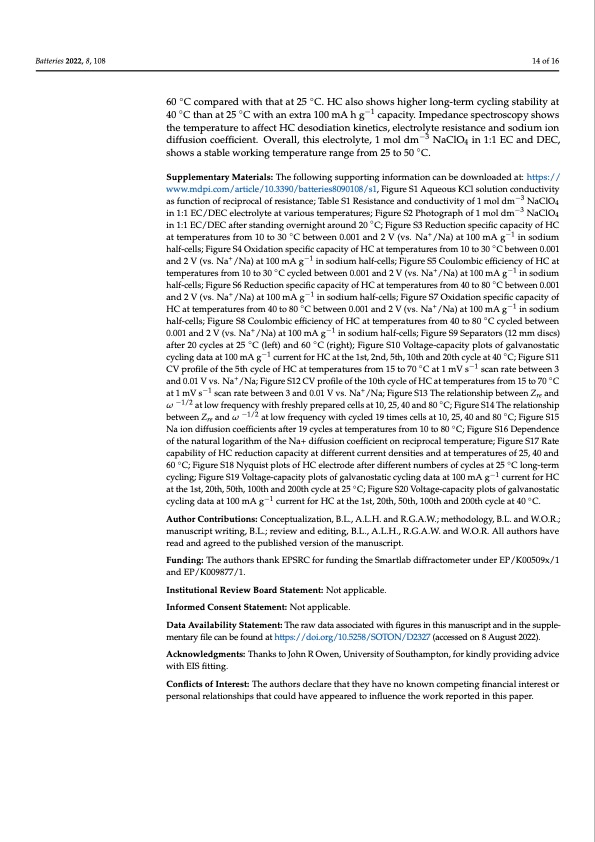
PDF Publication Title:
Text from PDF Page: 014
Batteries 2022, 8, 108 14 of 16 60 ◦C compared with that at 25 ◦C. HC also shows higher long-term cycling stability at 40 ◦C than at 25 ◦C with an extra 100 mA h g−1 capacity. Impedance spectroscopy shows the temperature to affect HC desodiation kinetics, electrolyte resistance and sodium ion diffusion coefficient. Overall, this electrolyte, 1 mol dm−3 NaClO4 in 1:1 EC and DEC, shows a stable working temperature range from 25 to 50 ◦C. Supplementary Materials: The following supporting information can be downloaded at: https:// www.mdpi.com/article/10.3390/batteries8090108/s1, Figure S1 Aqueous KCl solution conductivity as function of reciprocal of resistance; Table S1 Resistance and conductivity of 1 mol dm−3 NaClO4 in 1:1 EC/DEC electrolyte at various temperatures; Figure S2 Photograph of 1 mol dm−3 NaClO4 in 1:1 EC/DEC after standing overnight around 20 ◦C; Figure S3 Reduction specific capacity of HC at temperatures from 10 to 30 ◦C between 0.001 and 2 V (vs. Na+/Na) at 100 mA g−1 in sodium half-cells; Figure S4 Oxidation specific capacity of HC at temperatures from 10 to 30 ◦C between 0.001 and 2 V (vs. Na+/Na) at 100 mA g−1 in sodium half-cells; Figure S5 Coulombic efficiency of HC at temperatures from 10 to 30 ◦C cycled between 0.001 and 2 V (vs. Na+/Na) at 100 mA g−1 in sodium half-cells; Figure S6 Reduction specific capacity of HC at temperatures from 40 to 80 ◦C between 0.001 and 2 V (vs. Na+/Na) at 100 mA g−1 in sodium half-cells; Figure S7 Oxidation specific capacity of HC at temperatures from 40 to 80 ◦C between 0.001 and 2 V (vs. Na+/Na) at 100 mA g−1 in sodium half-cells; Figure S8 Coulombic efficiency of HC at temperatures from 40 to 80 ◦C cycled between 0.001 and 2 V (vs. Na+/Na) at 100 mA g−1 in sodium half-cells; Figure S9 Separators (12 mm discs) after 20 cycles at 25 ◦C (left) and 60 ◦C (right); Figure S10 Voltage-capacity plots of galvanostatic cycling data at 100 mA g−1 current for HC at the 1st, 2nd, 5th, 10th and 20th cycle at 40 ◦C; Figure S11 CV profile of the 5th cycle of HC at temperatures from 15 to 70 ◦C at 1 mV s−1 scan rate between 3 and 0.01 V vs. Na+/Na; Figure S12 CV profile of the 10th cycle of HC at temperatures from 15 to 70 ◦C at 1 mV s−1 scan rate between 3 and 0.01 V vs. Na+/Na; Figure S13 The relationship between Zre and ω −1/2 at low frequency with freshly prepared cells at 10, 25, 40 and 80 ◦C; Figure S14 The relationship between Zre and ω −1/2 at low frequency with cycled 19 times cells at 10, 25, 40 and 80 ◦C; Figure S15 Na ion diffusion coefficients after 19 cycles at temperatures from 10 to 80 ◦C; Figure S16 Dependence of the natural logarithm of the Na+ diffusion coefficient on reciprocal temperature; Figure S17 Rate capability of HC reduction capacity at different current densities and at temperatures of 25, 40 and 60 ◦C; Figure S18 Nyquist plots of HC electrode after different numbers of cycles at 25 ◦C long-term cycling; Figure S19 Voltage-capacity plots of galvanostatic cycling data at 100 mA g−1 current for HC at the 1st, 20th, 50th, 100th and 200th cycle at 25 ◦C; Figure S20 Voltage-capacity plots of galvanostatic cycling data at 100 mA g−1 current for HC at the 1st, 20th, 50th, 100th and 200th cycle at 40 ◦C. Author Contributions: Conceptualization, B.L., A.L.H. and R.G.A.W.; methodology, B.L. and W.O.R.; manuscript writing, B.L.; review and editing, B.L., A.L.H., R.G.A.W. and W.O.R. All authors have read and agreed to the published version of the manuscript. Funding: The authors thank EPSRC for funding the Smartlab diffractometer under EP/K00509x/1 and EP/K009877/1. Institutional Review Board Statement: Not applicable. Informed Consent Statement: Not applicable. Data Availability Statement: The raw data associated with figures in this manuscript and in the supple- mentary file can be found at https://doi.org/10.5258/SOTON/D2327 (accessed on 8 August 2022). Acknowledgments: Thanks to John R Owen, University of Southampton, for kindly providing advice with EIS fitting. Conflicts of Interest: The authors declare that they have no known competing financial interest or personal relationships that could have appeared to influence the work reported in this paper.PDF Image | Temperature Dependence of Hard Carbon Sodium Half-Cells

PDF Search Title:
Temperature Dependence of Hard Carbon Sodium Half-CellsOriginal File Name Searched:
batteries_08_00108_v2.pdfDIY PDF Search: Google It | Yahoo | Bing
Salgenx Redox Flow Battery Technology: Salt water flow battery technology with low cost and great energy density that can be used for power storage and thermal storage. Let us de-risk your production using our license. Our aqueous flow battery is less cost than Tesla Megapack and available faster. Redox flow battery. No membrane needed like with Vanadium, or Bromine. Salgenx flow battery
| CONTACT TEL: 608-238-6001 Email: greg@salgenx.com | RSS | AMP |